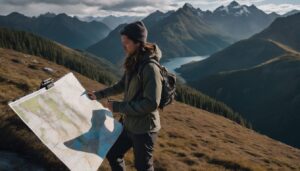
Discover the Best Time to Visit Alaska with our comprehensive guide.
Alaska is the largest state in the United States, and its remote and isolated location makes it a truly unique destination for travelers.
Whether you want to explore the rugged wilderness, see incredible wildlife, or learn about the state’s rich history and culture, Alaska has something for everyone.
However, deciding when to visit can be challenging due to the state’s extreme climate and ever-changing weather patterns.
In this guide, we will provide an overview of the best time to visit based on your interests and preferences, as well as highlight some of the top activities and events for each season.
Summer Season (May to September)
Summer is the most popular time to visit Alaska, and for a good reason.
The weather is generally mild, with temperatures ranging from the 50s to the 70s Fahrenheit (10-25 Celsius).
The long days provide ample time for outdoor activities, and wildlife viewing opportunities are abundant.
Weather conditions
Summer weather in Alaska can vary significantly depending on the region.
The southern part of the state experiences the warmest temperatures, while the northern part can be cooler and more unpredictable.
Rain is common, particularly in coastal regions, so be sure to pack rain gear and waterproof clothing.
Wildlife viewing opportunities
Summer is the best time to see Alaska’s famous wildlife, including bears, moose, caribou, and whales.
Many animals are active during this season, and wildlife tours and excursions are readily available.
Outdoor activities
Summer is an excellent time for outdoor activities such as hiking, fishing, kayaking, and rafting.
The long days provide ample time for exploration, and many of Alaska’s national parks and wilderness areas are open during this season.
Fall Season (September to November)
Fall is a beautiful time to visit Alaska, with vibrant foliage and fewer crowds than in the summer months.
The weather can be unpredictable, but for those willing to take a chance, fall can be an excellent time to experience the state’s natural beauty.
Weather conditions
Fall weather in Alaska can be variable, with temperatures ranging from the 20s to the 60s Fahrenheit (-7 to 16 Celsius).
Rain and snow are common, particularly in the later months of the season.
Visitors should be prepared for cooler temperatures and occasional snowstorms.
Northern Lights
One of the biggest draws of visiting Alaska in the fall is the chance to see the Northern Lights, also known as the Aurora Borealis.
September through November is considered the best time to see the lights, and many tour operators offer Aurora viewing excursions.
Festivals and Events
Fall is also a great time to attend festivals and events in Alaska, such as the Sitka WhaleFest, the Alaska State Fair, and the Anchorage International Film Festival.
These events offer a chance to experience the state’s culture and community.
Winter Season (December to April)
Winter in Alaska is a truly unique experience, with snowy landscapes, winter sports, and the chance to see the Northern Lights.
However, it is also the coldest and darkest season, and visitors should be prepared for extreme weather conditions.
Weather conditions
Winter temperatures in Alaska can drop well below freezing, with some areas experiencing temperatures as low as -40 Fahrenheit (-40 Celsius).
Snow is common, particularly in the mountains and northern regions of the state.
Visitors should be prepared with warm clothing and appropriate gear.
Northern Lights
Winter is the best time to see the Northern Lights, with dark and clear skies providing the best viewing conditions.
Many tour operators offer Aurora viewing excursions, and visitors can also see the lights from towns and cities throughout the state.
Winter sports
Alaska is a popular destination for winter sports, including skiing, snowboarding, dog sledding, and snowmobiling.
Many resorts and outdoor recreation areas offer activities and equipment rentals for visitors.
Spring Season (April to May)
Spring is a beautiful time to visit Alaska, with snow melting and wildlife awakening from winter hibernation.
The weather can be unpredictable, but for those willing to take a chance, spring can be an excellent time to experience the state’s natural beauty.
Weather conditions
Spring weather in Alaska can be variable, with temperatures ranging from the 20s to the 60s Fahrenheit (-7 to 16 Celsius).
Rain and snow are common, particularly in the earlier months of the season.
Visitors should be prepared for cooler temperatures and occasional snowstorms.
Wildlife viewing opportunities
Spring is an excellent time to see Alaska’s wildlife, including bears, moose, and migratory birds.
Many animals are active during this season, and wildlife tours and excursions are readily available.
Festivals and Events
Spring is also a great time to attend festivals and events in Alaska, such as the World Ice Art Championships in Fairbanks and the Kachemak Bay Shorebird Festival in Homer.
Conclusion
Alaska is a unique and incredible destination that offers something for every traveler.
Whether you want to explore the rugged wilderness, see incredible wildlife, or experience the Northern Lights, there is no bad time to visit Alaska.
However, each season offers different experiences and opportunities, and it’s important to plan your trip based on your interests and preferences.
FAQs
1. What is the best time to see the Northern Lights in Alaska?
The best time to see the Northern Lights in Alaska is during the fall and winter months, particularly from September to November and December to April.
2. What is the warmest time of year in Alaska?
The warmest time of year in Alaska is during the summer months, from May to September.
3. When is the best time to see wildlife in Alaska?
The best time to see wildlife in Alaska is during the summer and spring months, from May to September and April to May.
4. Is it possible to visit Alaska in the winter?
Yes, it is possible to visit Alaska in the winter, but visitors should be prepared for extreme weather conditions and should plan accordingly.
5. What should I pack for a trip to Alaska?
Visitors to Alaska should pack warm clothing, including jackets, hats, gloves, and boots, as well as rain gear and layers for changing weather conditions.
It’s also a good idea to bring binoculars, a camera, and any necessary medication.








